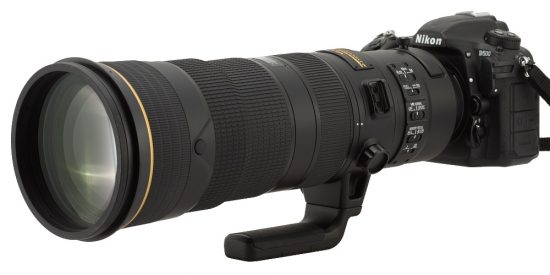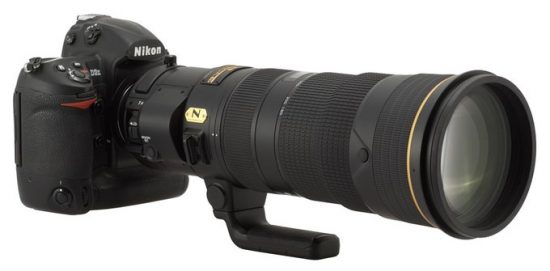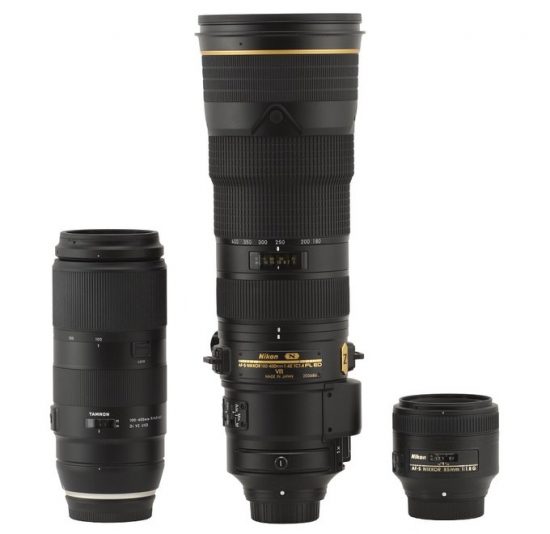


More review of the Nikon AF-S Nikkor 180-400mm f/4E TC1.4 FL ED VR lens (price: $12,396.95, currently in stock at Amazon) – the first one is from Lenstip:
Pros:
- very solid, weather-protected casing,
- sensational image quality in the frame centre and the 180-400 mm range,
- excellent image quality on the edge of the APS-C/DX sensor in the 180–400 mm range,
- very good image quality on the edge of full frame in the 180–400 mm range,
- negligible longitudinal chromatic aberration,
- slight lateral chromatic aberration,
- imperceptible spherical aberration,
- lack of distortion problems,
- very good astigmatism correction,
- negligible vignetting for the APS-C/DX sensor,
- silent and accurate autofocus,
- pleasant blurry areas,
- very efficient image stabilization.
Cons:
- too weak performance after switching the teleconverter on,
- very poor performance against bright light,
- distinct vignetting on full frame detector.
If a 180-400 mm model without the built-in teleconverter was the successor of both Nikkors 200-400 mm we would be delighted with its performance and our summary would be full of oohs and aahs. As it is, the results the tested lens at 550 mm which was created by adding a dedicated, integral teleconverter to the system, leave a lot to be desired. It used to be a norm, such image quality decrease after joining a lens with a teleconverter. After launching 1.4x and 2.0x devices of the newest generation which are complex optical systems of their own, with 5-7 elements inside, that cooperation improved a lot. I admit my expectations were rather high when it came to the tested Nikkor. As you deal here with a teleconverter with as many as eight elements which, additionally, could be optimized to cooperate smoothly with just one optical system (or, in fact, a ‘prime’ because in over 90% of cases the teleconverter will be switched on with the proper focal length set at 400 mm and at that place their cooperation should have been as perfect as possible) I expected just a minimal decrease of quality. Instead I got a distinct drop of quality, in some cases exceeding even 10 lpmm. It is most definitely not an effect you would expect from a lens costing over $12000.
That weaker performance can be noticed not only in photos of our testing charts or measurements but also in our sample shots. With the lens and the D3x set, where you deal with a full frame 24 Mpix sensor, the photos taken at 550 mm and examined in the 1:1 scale might seem to be still of good quality but if you shot them with a much more densely packed sensor of the Nikon D500 you can feel unsatisfied.
To be honest when I took the tested lens attached to the Nikon D500 for an outdoor session I spent a lot of time trying to calibrate the autofocus at the 550 mm focal length in many different ways. The photos I got simply seemed so fuzzy to me that I suspected some front- or back-focus problems. There were no such problems after all and the impression of fuzziness was created by the huge contrast between the performance at 400 mm, excellent indeed, and quite average results you get when you employ the teleconverter.
In order to balance my summary out and not to go over the top with carping I want to add that if you buy this lens for the 180-400 mm range you will be delighted because in e.g. sport photography it will perform brilliantly well. The 550 mm focal length will manage well too but only as a last resort. These photographers, however, who prefer longer focal lengths and want to use them in situations when you have to crop your images a bit (bird photography for example) in our view would really fare better if they bought a good quality prime.
Brad Hill also recently published his feedback on the Nikon AF-S Nikkor 180-400mm f/4E TC1.4 FL ED VR lens:
1. First Impressions – Build Quality.
Just superb! This Japanese-made lens simply exudes quality. Zoom and focus rings couldn’t rotate more smoothly (nor could their “friction” or resistance to turning be dialed in any better)…
2. First Impressions – Physical Characteristics: Length and Weight.
The lens is virtually identical in length to the 200-400 f4 VR zoom it is functionally replacing. Nikon claims the weight to be 3500 grams (7.7 lb). My copy came to EXACTLY this weight – once I removed the “caps” from both ends AND took the hood off…
3. First Impressions – Physical Characteristics: Balance.
Ahhh…THIS is what Nikon got right – especially if you’re shooting a D5 (or one of its D-single-digit precursors) or a “semi-pro” Nikon DSLR with a battery grip attached. I find the balance – and consequently the ease of hand-holding the lens – to be just excellent…
4. First Impressions – Physical Characteristics: Tripod Foot.
Well…Nikon has finally realized that virtually no one has hands the size of the Hulk…and they’ve reduced the “drop” down to the tripod foot considerably….
5. First Impressions – Ergonomics.
Like with other recently introduced “new” zooms, Nikon has moved the zoom ring to the distal end of the lens. Unlike some other recent zoom lens introductions (e.g., the Nikkor 70-200mm f2.8E) the zoom ring IS still accessible when the lens hood is in the “carrying” (i.e., reversed position)…
6. Preliminary Testing – Optical Quality
So…what have I found with the preliminary systematic testing done to date? Two things have already jumped out:
- The 180-400mm has absolutely amazing edge-to-edge sharpness at all focal lengths when shooting distant subjects, even on the D850. Like…top-notch prime lens quality.
- I have NEVER seen a lens where the difference in sharpness (both in the center AND on the edges) between images shot with the aperture wide open vs. those shot after stopping down by 2/3 to a full stop is so trivial. In other words, this lens is very, very close to its maximum sharpness when shot absolutely wide open (and at ALL focal lengths). To some this may not sound like a big deal, but for someone like me (who shoots a lot in low light and is comparing the lens against top-notch primes like the Nikkor 400mm f2.8E) this is just HUGE.
Previously published Nikon AF-S Nikkor 180-400mm f/4E TC1.4 FL ED VR lens reviews:
Nikkor AF-S 180-400mm f/4 ED TC VR lens field test report by Roy Mangersnes
Nikon AF-S 180-400mm f/4 ED TC VR first look review and sharpness comparisons by Steve Perry
Dpreview’s sample gallery: Nikon AF-S 180-400mm f/4 ED TC VR lens
Nikon Nikkor AF-S 180-400mm f/4 ED TC VR lens now shipping, new test photos
Nikon Nikkor AF-S 180-400mm f/4 ED TC VR lens reviewed at Ephotozine






